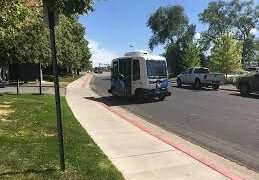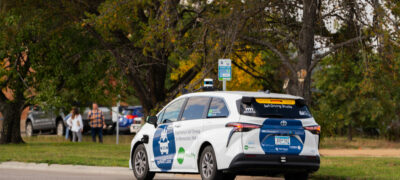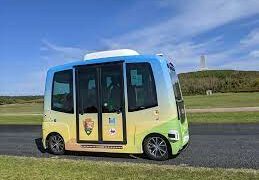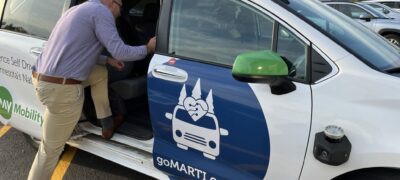
Hello Everyone,
News this month of the global COVID-19 epidemic is reminding all of us about the downside of a completely connected world, but technology is going a long way to help shut down the epidemic in the country of its origin – China. The Chinese are using automated delivery vehicles to reduce person-to-person contact. In a Bloomberg News article, Yu Enyuan, the founder of Neolix, a driverless delivery business in Beijing is reported as describing the company’s now booming business.
Neolix’s inventories have been depleted during the epidemic as its vehicles have been used to deliver medical supplies in hospitals, including in Wuhan, at the outbreak’s epicenter. Its vans are also being used to help disinfect streets and move food to people who are working on the front lines to curb the spread of the virus, Yu said.
“Demand has been surging since the virus outbreak and more importantly, people’s perception toward driverless delivery had a complete 180-degree shift,” Yu said. “People realize that such vehicles can get things done when it is risky for a human being to do so.”
For practical advice on how rural and small urban transit can immediately weather the current epidemic, be sure to read the Hot Topics webpage section on Coronavirus that National RTAP has added for rural transit agencies.
Enjoy those early pre-spring flowers,
Sheryl Gross-Glaser
Editor, N-CATT Tech News
Director, National Center for Applied Transit Technology
Community Transportation Association of America
grossglaser@ctaa.org
202.386.1669
Resource of the Month
Innovation and Modernization in Transportation Departments
Advice for modernizing transportation departments is available from the National Cooperative Highway Research Program (NCHRP), which recently released a report entitled Guide to Creating and Sustaining a Culture of Innovation for Departments of Transportation. This guide underscores the importance of innovation in any organization, while providing simple steps that transportation organizations can implement to not only encourage innovation, but to completely change outdated cultures. While simple, these steps are not necessarily easy.
As transportation technology continues to advance, and private companies such as Uber are taking advantage of it, public transportation departments are at risk of falling behind. As revenues shrink and maintenance of old infrastructure becomes more expensive, NCHRP states that adopting a culture that promotes innovation can help alleviate these problems. Although there is no single way this can take shape, as each department of transportation (DOT) has its own specific circumstances and issues that it needs to address, just acknowledging the importance of innovation through all levels of a department is an important step. While intended for the larger organization of a state DOT, this guide is applicable to small transit agencies as well.
Creating a Culture of Innovation
While it is easy for a DOT to proclaim that innovation is important and welcome, creating a culture of innovation requires collaboration between leadership and employees, where everyone is open to change and encouraged to generate ideas. Establishing a clear vision or goal for the organization and a system that allows to people to pitch, review, and implement ideas are crucial to maintaining this kind of culture. It is also important to allow for the airing of ideas that may be groundbreaking or smaller scale. An innovation culture often creates enthusiasm throughout a department, where everyone feels fully invested in and a part of the organization.
The Five Building Blocks of Innovation
NCHRP enumerates five building blocks that are important to creating and sustaining a culture of innovation.
- Leadership: Management makes clear the importance of innovation. Creating clear goals and values for everyone to work together on, keeping everything streamlined, and providing time and a structure for employees to create and work on ideas are steps that leadership can take to begin this culture change. The Idaho Transportation Department (ITD) created an Innovation Team that created a web platform called Innovate ITD! where people may submit innovation ideas easily, and where they can be categorized clearly. This kind platform helps encourage innovation by making it easy for anyone to pitch ideas.
- Empowerment: All employees must be welcomed to contribute to the organization’s growth. This is done by crowdsourcing ideas, offering innovation training, and encouraging teamwork. The Connecticut Department of Transportation offers leadership training, with a specific focus on innovation with The Innovation Project. This training has allowed employees to come up with ideas and make significant improvements to their DOT.
- Communication – both within an organization and outward to the customers: This includes sharing innovation ideas with employees and constituents with branding, newsletters, and innovation fairs. Both California’s and Arizona’s DOTs host annual fairs to help spur innovation and to exchange ideas.
- Recognition: Rewarding employees for innovation and valuing their sense of investment in a new culture of innovation. This takes the form of offering awards such as ITD’s annual “Best of the Best” Awards or their InnovateITD! Ribbons, which are given to employees who submit ideas.
- Measurement: Innovation needs to have clear goals and measurable achievements. Track cost, time and satisfaction to make sure that the approach to innovation is effective.
With these steps, NCHRP hopes to impart how innovation can be and is being used to help DOTs that have had a hard time modernizing their organizations. Any transit agency looking to expand and modernize should look at this guide and ponder the success stories it shares.
A Common Data System for DRT
Demand-response transportation (DRT) often relies on outdated technology or insulated systems to process and fulfill customer requests. These practices make coordination among different agencies nearly impossible, complicating the customer experience and reducing opportunities for efficiency. Technology already exists to streamline processes for scheduling, dispatch, and payment, thus enabling a system that allows disparate agencies to work together to fulfill requests. The Transit Cooperative Research Program (TCRP) is encouraging widespread use of a new standard data specification system to achieve this.
A New Unified Data Specification Is a Tool for Cooperation
This kind of coordinated system is already in place for airline reservations, where multiple airlines work together to enable coordinated booking and payment from one location to another. A DRT system like the one TCRP is encouraging is currently operating in Denmark. Called FlexDanmark, the Danish system is expanding passengers’ choice of transportation by using a unified data standard. AARP has produced videos and a report to spread word in the US about the success of this system. Widely adopting a unified data specification is an early step that transportation providers can implement that would help simplify customer use of DRT systems as well. This can be a long process: Full implementation, even with government support, could take a decade.
Two key takeaways from the report are that financial benefits for transportation agencies, providers, and stakeholders must be clear and that government support or encouragement will be a significant factor.
One common theme from the five [case studies presented in the report] is that interested parties will pursue data standardization if they are able to readily perceive how it benefits their organization, particularly financially. In every case where the data standards or specifications advanced, there were organizations involved in the process that clearly saw the concrete benefits of such standards and had a financial incentive to support their implementation and further development. For example, the airline industry could not function without the ability of airlines to exchange data on customer itineraries that involve multiple airlines. The airline industry participants all recognize the importance of the data exchange and have worked to achieve collective benefits from the framework that has existed for over 50 years.
Preparing for Automated Vehicles: National and International Approaches
For the past four years, there have been transit AVs operating in Switzerland and in Australia. While these are few in number and geographic reach, the global competition to develop AVs is fierce and active. The US is a major player, but reasonable minds are debating incentives for innovation, how to ensure safety and protect privacy, and methods for promoting best practices.
From USDOT to the Many Federal Programs Intertwined with AV Development
In January, Secretary of Transportation Elaine Chao released what is commonly referred to as AV 4.0, but officially entitled Ensuring American Leadership in Automated Vehicle Technologies. Unlike the previous guidance on automated vehicles (AVs) from the US Department of Transportation (USDOT), this document was co-authored by the National Science and Technology Council. It is not so much a guide to US policy, laws, and regulation related to AVs as a catalogue of federal agency responsibilities and programs. AV 4.0 does not represent change. Like its predecessors, this guidance emphasizes voluntary reporting and development of standards through consensus building.
USDOT Wants Your Comments
Av 4.0 is not a static document; rather it is part of an ongoing national conversation. In that vein, USDOT is seeking your comments in response to AV 4.0. Click here for more information. Comments of whatever length may be submitted via regulations.gov. USDOT is certain to hear from large cities and metropolitan areas as well as the auto and tech industries. Your voices are important to this conversation.
Coordinating and Encouraging Accessibility
Sec. Chao has made it a hallmark of her reign at the USDOT to declare the great promise that AVs hold for people with disabilities and older adults.
AVs hold enormous potential to promote the independence, economic opportunities, and social well-being of older Americans and persons with disabilities by offering independent mobility for daily activities. Reducing transportation related obstacles would enable new employment opportunities for individuals with disabilities and could save billions annually in healthcare expenditures from missed medical appointments.10 Ensuring that AVs will meet the needs of Americans of all abilities will require carefully thought-out inclusive design to ensure widespread usability and market potential for persons with all types of disabilities-visual, auditory, cognitive, mobility, and others.
AV 4.0 mentions research funded by the US Department of Health and Human Services on interior AV designs that are accessible and that addresses AV solutions to first mile and last mile challenges for people with disabilities. AV 4.0 briefly discusses the role of the US Department of Justice in enforcing the Americans with Disabilities Act (ADA) and the power entrusted to the National Transportation Highway Safety Administration (NHTSA) to “set performance requirements for adaptive motor vehicle equipment and develop exemptions that permit the modification of motor vehicles used by persons with disabilities.” However, in keeping with the previous administration, the discussion never veers from encouragement and possibility to endorsing strategies or imposing requirements for widespread availability of accessible AVs.
Beyond Federal Partners
While AV 4.0 explains the broad reach of federal government programs that relate to AV research, safety, cybersecurity, connectivity, and planning, it also speaks of the roles of private industry to innovate and develop cybersecurity standards, and of state and local governments to manage the transportation networks in which AVs will operate.
For the tech and automobile industries, there are no AV compliance requirements, only voluntary assessments and “no waiting period or delay to begin testing or deployment.” AV 4.0 explicitly leaves cybersecurity leadership to the private sector, while providing federal guidance through NHTSA’s non-binding best practices. Because AVs are not yet widely deployed, how these voluntary practices will fare when tort litigation occurs – and the reasonable person or business standards apply – remains to be seen. Thus far, AV-related crashes have led to quick settlements and not to protracted litigation and judicial decisions. (Litigation around the performance of the Tesla Autopilot software is inherently different because the question is not only whether Autopilot performed adequately, but whether the driver was monitoring the vehicle’s operation and whether the driver should have taken over control of the vehicle. The questions will fundamentally change when there is no driver and software and hardware determine even whether a remote human operator is called to step in.)
Rural and Tribal
The focus of AV 4.0 is on governmental responsibilities and the concise description of programs inside and outside of the USDOT. There is not much that explicitly addresses rural and tribal America. A quick search does uncover a theme of involving stakeholders from all types of communities and ensuring a consistent federal approach for all of them as well. As mentioned above, click here for more information and submit comments at this webpage on regulations.gov.
Parallels in the United Kingdom
The UK government structure, legal framework, and standards around private and public transportation are similar to those in the US. That country’s exploration of how to serve the full range of populations with maximum accessibility and availability of publicly available transportation therefore presents an intriguing and instructive discussion. Though lacking a memorable title, Automated Vehicles: Consultation Paper 2 on Passenger Services and Public Transport beautifully summarizes the concerns of rural and small urban transit and transportation service providers. And it does so in the context of the ambitious goal of universal AV accessibility.
The sections on accessibility and co-design with people who have a range of different disabilities are worth reading. They cover such concerns as:
- Redundancy as part of multiple accessible communication formats – including non-digital options,
- Safe, accessible pick-up and drop-off locations,
- Using data to predict accessibility as part of demand,
- Allowing caretakers to accompany people with disabilities,
- Measures to prevent bullying and other antiseptic behavior on publicly available transportation, and
- Expanding the idea of accessibility to encompass power wheelchairs and scooters.
Similar to the US, this document, which is part of an in-depth series of reports, evinces an awareness that China in particular is leading, ambitious, and coordinated in its AV plans for public transportation. The report also offers the concept of compliance-based ADA enforcement rather than the current complaint-based system, which has placed the onus on individuals with disabilities to report, explain, and pursue complaints to enforce rights that most of us take for granted.
The International Picture
Every developed nation is seeking to be in the lead in reaching the goal of full vehicle automation and in planning for AV transportation networks. The Global Guide to Autonomous Vehicles 2020 examines various aspects of infrastructure, planning, and legal developments in many of the leading AV nations, including the US. This includes cellular availability, privacy rights and cybersecurity, and top-down preparation for AVs as part of broader economic planning. This is a guide that offers insights into a range of approaches. It is even an excellent source of information about US planning, activities in Congress, and in each of our 50 states and the District of Columbia.
China, for example, has established a national framework for AV permitting and operations, with local governance of taxis and public transportation. Currently, low speed AV shuttles are operating commercially on enclosed campuses. AV taxi licenses are being granted in Shanghai with a graduated system that allows for increasing the number of AVs after six months of good performance. China has data privacy rules in force and a nation policy in favor of prioritizing the rollout of 5G.
While the Global Guide offers a comprehensive assessment of China, the US, Germany, the UK, Canada, Australia, and New Zealand, it leaves out some places that are investing heavily in preparation for and encouragement of the AV revolution, such as the United Arab Emirates (particularly the city of Dubai), the city-state of Singapore, Japan and Switzerland. This is the guide to read, however, for a deep dive into planning, legal rules, data and privacy protections, and the status of testing, pilots, and other types of AV operations.
N-CATT Meows on Twitter
Find N-CATT meows at @TransitNCATT.
- The Illinois Autonomous Vehicle Association held an event with stakeholders “from public, private, and academic institutions, splitting up into three areas: movement of goods, people, and agriculture.” Goal is white papers by summer 2020.
- Right on predictions for applied #transit technology trends for 2020. These focus on large cities and urban areas, but lessons and adaptations possible for rural and small urban.
- Uber is asking a federal judge in Pittsburgh area to dismiss an ADA class action lawsuit brought by wheelchair users. Company says plaintiffs never downloaded or used the app.
- BUILD grants may support transit, rail, or intermodal transportation projects.
- From National RTAP: Join our #ClimateTransit Twitter chat on April 21, 2020, 2-3 PM ET to discuss how climate change could impact rural transit. The chat will be led by Josh Goldman of @ClimateNexus. Panelists are Jimmy O’Dea of @UCSUSA and Camron Gorguinpour of @WorldResources. – Find National RTAP on Twitter at @nat_rtap.
- For #transit agencies in rural and small urban markets, the question is whether the costs of #fare technology, fare enforcement, delays while paying on the bus, and lack of substantial fare revenue make #farefree an attractive option.
- Australian #senior community puts into service an @Easy_Mile AV shuttle. People who had not left their homes for months are socializing. Not reported as a pilot, but as a permanent transportation service. #autonomousvehicle
N-CATT Videos on the Bus
DOE Works for Transit
Many transit systems are considering switching to alternative fuels or battery electric buses. Energy 101: Sustainable Public Transportation, produced by the US Department of Energy (DOE), provides a brief overview with examples of transit systems and National Park transportation programs that have already gone this route. DOE posts resources related to sustainable transportation, including information about energy efficient mobility, technology integration, and batteries, charging, and electric bus infrastructure.
CAT on the Bus
This month’s cats on the bus are of the cartoon variety and they come singing that classic song The Wheels on the Bus, complete with a stanza of “the cats on the bus go meow, meow, meow.” This US folk song was written by Verna Hills (1898-1990) and was published in 1939. It is sung to and by children throughout the English-speaking world. The song is unrelated to the book Cat on the Bus, which tells the story of a homeless cat who finds a friend and a home when he runs into a kind gentleman on a bus.




